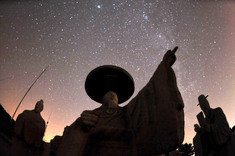Running short on holiday cash? Tired of commuting in a ’03 Saturn Ion? Desperately want your favorite NFL team to get on track? Look skyward on Wednesday night (Dec. 13) and you should see plenty of shooting stars to wish upon.
Tradition has it that wishes made on shooting stars come true. But astronomy has it that they are actually tiny particles no larger than sand grains and with the consistency of cigar ash, that collide with the Earth’s atmosphere and streak across the sky in a blaze of incandescent gas as they descend from space and disintegrate. [Geminid Meteor Shower 2017: How and When to See It ]
And very soon it will be time for the best of the annual meteor displays: The Geminid meteor shower.
This excellent late-autumn shower will peak during the overnight hours of Dec. 13 – 14 for observers in North America. A slender crescent moon, which will rise around 3:30 a.m. local time, should not interfere — well-deserved compensation for last year, when the shower peaked at the time of a dazzling “supermoon” full moon .
Great balls of fire!
In recent years, the Geminid meteor shower (nicknamed by some as the “Gems”) have been generous, with maximum rates of 60 to 120 per hour for a single observer under ideal dark-sky conditions.
But here are two important disclaimers:
- Light pollution greatly cuts the numbers of visible meteors; city and streetlights for instance can overpower the light of many of the fainter meteors.
- Tall trees and buildings also lower the numbers. In contrast, the wider the expanse of visible sky, the more meteors you will see.
Fortunately, more than a few “Gems” tend to be outstandingly bright and are known as fireballs . Rarely, one or two might appear to silently explode as they hit the Earth’s atmosphere at nearly 81,000 mph and are capable of briefly casting shadows on Earth. Astronomers call these “bolides.” [December Lights: 6 Super Facts for the Geminid Meteor Shower ]
Just the sight of one of these kinds of meteors will make the night worthwhile.
Numb’s the word!
But you might need to see a few of these to offset the weather conditions that are typical in mid-December, with temperatures more suitable for a hot bath than a meteor shower. Indeed, December nights can be quite cold. So if you plan to watch, make sure you’re adequately bundled up. In such cases, a thermos jug of a hot beverage (like cocoa, tea or coffee) can be a good companion.
The cold weather makes the Geminid meteor shower less popular than the famous Perseid meteor shower of mid-August, which is unfortunate because the Geminids are now considered to be the more prolific of the two meteor displays.
This shower’s shooting stars radiate from a point near the bright star Castorin the constellation Gemini , hence the shower’s moniker, “Geminid.” That region of the sky is nearly as far from the sun as one can get in mid-December. As a result, the radiant rises to a respectable elevation only a few hours after sundown and remains high in the sky for the rest of the night. This means you can watch for meteors at a reasonably convenient hour – read that as any time after about 10 p.m. And Castor will be high overhead around 2 a.m. By lying on your back, you can see meteors shooting out of that region of the sky like the spokes of a wheel.
‘Gem season’: Dec. 7-15
Geminid activity builds slowly: forerunners of the main display are few and far between and begin appearing around Dec. 7. Activity gradually ramps up to maximum, and about half as many meteors (30 to 60) are seen on the night before peak activity. On the night after the peak, the numbers will have rapidly dropped off to only about a quarter of the peak rate (15 to 30), and just two nights after the peak, only a few lingering stragglers might be noted.
In all, it is the kind of astronomical event that the public can relate to, and amateur astronomers love it.

0 of 10 questions complete
For more information, Space.com has everything you’ll need to know about when, where and how to see this year’s Geminidsin this handy Geminid meteor shower viewing guide .
Editor’s note: If you capture an amazing view of the Geminid meteor shower or any other night- sky view that you would like to share with Space.com for a possible story or gallery, send images and comments in to: spacephotos@space.com.
Joe Rao serves as an instructor and guest lecturer at New York’s Hayden Planetarium. He writes about astronomy for Natural History magazine, the Farmer’s Almanac and other publications, and he is also an on-camera meteorologist for Verizon Fios1 News in Rye Brook, New York. Follow us @Spacedotcom , Facebook and Google+ . Original article on Space.com .

Comments are closed.